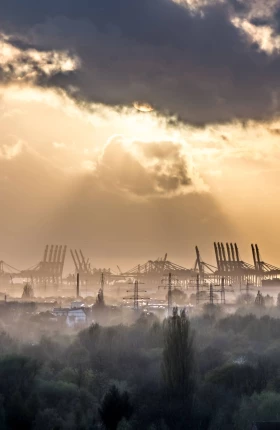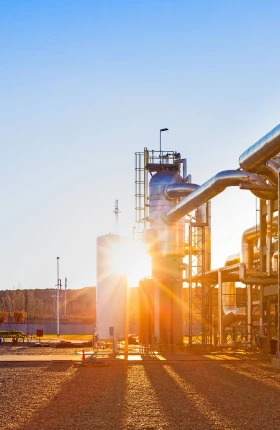Eight realities are shaping the “energy trilemma.” Here’s how business and government can keep the energy transition on track.
The energy trilemma is not new. For decades, companies and policymakers have struggled to balance the three goals of ensuring a secure and reliable energy supply, at an affordable cost, with minimal environmental impact. But the redoubling of global ambition on climate change at COP26, followed by Russia’s invasion of Ukraine, makes the challenge even greater, as the prices of energy and other commodities surge across the globe.
What will happen next? In some regions, these issues may cause the energy transition to accelerate, driving security and objectives simultaneously. But energy costs have increased sharply and likely will remain elevated for some time, which could lead to a backlash against climate action if end users’ expectations and costs are not managed carefully.
In short, we are at an energy inflection point. Business and government must develop new strategies to ensure that the pursuit of critical energy goals remains on track.
Eight realities will shape the contours of our energy future. We’ll consider each in turn.
The Power of Policy Making
Policymakers will continue to rewrite the rules of the game over the next 12 months, and the effect of these policies may endure for decades.
The fallout from Russia’s invasion of Ukraine is only the latest example of how concerns over energy security alter the direction of policy, with impacts on supply and demand in many regions. The 1979 energy crisis, which occurred in the wake of the Iranian Revolution, kick-started the global interest in renewable energy. It also led to an investment in research and policies that accelerated the transition away from oil. Japan, for example, enacted its Energy Conservation Act, which has helped to decrease oil’s share of the country’s energy consumption from 72% to just 38% today. Many other countries enacted supply-side policies to find domestic alternatives to imported oil and gas; rather than accelerating the move to renewables, those moves boosted coal production.
The fallout from Russia’s invasion of Ukraine is only the latest example of how concerns over energy security alter the direction of policy.
Fast-forward to today: Germany has rewritten its energy strategy virtually overnight after relying for decades on Russian oil and gas imports as a pillar of its economic growth strategy. Clearly, geopolitical events have a significant impact on energy policy. But unlike in the past, climate action is also now a critical component of regulatory, legislative, and industry thinking.
Energy security policies can have far-reaching effects. Often they create constituencies with an incentive to retain or even expand the policies further. Look no further than the US Renewable Fuel Standard, which was intended to reduce emissions and kick-start demand for biofuels by mandating minimum sales volumes. In practice, this has become a cash cow for US farmers and led to a change in US land use from food to fuel production. It has also strengthened the farm lobby, which campaigns hard to keep these subsidies in place.
New Energy Security Challenges
The global dependence on hydrocarbons will likely decline over time. But new dependencies on critical minerals and technology will arise, requiring careful management.
The minerals powering the energy transition will need additional investment across multiple countries and along the entire value chain. These supply sources and demand sinks will create new points of vulnerability and alter the geopolitics of energy policy. An estimated $2 trillion in investment is required to limit global warming to the oft-stated goal of 1.5 degrees Celsius. This investment will, in turn, create new centers of economic and geopolitical advantage for countries with ready sources of lithium, nickel, rare earths, and other critical minerals.
As a result, governments will increasingly look to secure supplies of critical minerals and energy from domestic or friendly sources—a practice known as “friendshoring.” The EU’s critical minerals strategy, for example, calls for diversifying and securing the supply of some 30 commodities, underscoring how much work remains in sourcing key components of the energy transition from reliable and politically favorable markets.
Broader environmental, social, and geopolitical considerations will also play an increasingly important role. For example, 70% of global cobalt production is currently located in the Democratic Republic of the Congo, which has a poor record on workers’ rights. Similarly, 20% of the global nickel supply comes from Russia and can no longer be exported to Western markets because of sanctions. Proposals such as the EU battery passport—which would track a battery’s material provenance, chemical makeup, and sustainability impact—are designed to ensure the energy transition does not come at an unacceptable social or environmental price.
A Shortage of Energy Efficiency Measures
Reducing the consumption of energy through more-efficient use is often referred to as the “first fuel,” because this approach can reduce use the most and be implemented relatively quickly. It also has positive cost and climate implications. To that end, the IEA has put out a ten-point plan to reduce oil demand by 2.7 mmb/d within four months, largely by changing consumers’ behavior.
But no country has to date enacted policies to immediately restrict energy use or sharply increase efficiencies. Instead, countries are contemplating or implementing subsidies—such as suspending taxes, employing price caps, or providing discounts—to reduce the impact of higher prices on end users. We see this happening in Europe. France, for example, has spent €20 billion to moderate gas and power costs and is considering fully nationalizing EDF, the national electric utility. Spain has imposed price caps on fuel, extending a cap already in place on household energy usage. And the UK has lowered taxes on road fuel while offering discounts to domestic users of gas and electricity.
These policies will have the opposite impact of efficiency measures, boosting demand at the margins and potentially creating market shortfalls. Such scarcity can create a doom loop, in which scarcity or perceived scarcity leads to hoarding, which exacerbates scarcity. This occurs frequently during the US hurricane season, when motorists preemptively fill up their tanks, causing fuel stations to run empty.
Higher Decarbonization Costs
Higher costs are forcing governments to make tougher tradeoffs between affordability and decarbonization, a situation that often favors fossil fuels in the very near term. In several countries, it is now cheaper to replace natural gas with coal, which has approximately 40% more carbon emissions and contains particulate matter that worsens air quality. In Europe, where carbon pricing is well established, permit costs have, to some extent, prevented this shift, though Germany is now planning on maintaining some coal plants to provide optionality when natural gas prices are high.
Higher costs are forcing governments to make tougher tradeoffs between affordability and decarbonization, a situation that often favors fossil fuels in the very near term.
Indeed, the effects of the energy transition could have significant repercussions. In Brazil, where consumers can choose among fuels with a variety of ethanol levels, the higher gasoline prices are pushing mills to create more ethanol, reducing sugar availability globally. This will further push up prices, potentially increasing social unrest.
In addition, patchy implementation of nations’ COP26 carbon reduction commitments could lead to disparities in energy costs between high-action and low-action regions, a situation that would incentivize offshoring. New initiatives, such as the EU Carbon Border Adjustment Mechanism, which taxes imports of energy-intensive products, may help resolve the issue.
Higher commodity prices, due in part to the war in Ukraine, may disrupt cost curves in both directions and across commodity types. The input costs for three key metals (nickel, lithium, and cobalt) for a 60 KWh electric-vehicle battery have risen sharply, from $1,395 a year ago to $7,400 in April 2022, which could slow the uptake of EV penetration. At the same time, springtime prices for jet fuel in New York Harbor exceeded $300/b, a price so high that sustainable aviation fuel is not just competitive, it’s cheaper. And EU carbon prices have hit new highs of €100/ton, making a new range of decarbonization options more affordable.
Government Investment and “Greenflation”
Renewable power producers were experiencing constraints before Russia invaded Ukraine and cut off supply. Several wind OEMs had cited supply chain issues involving electrical components, balsa trees needed for blades, and general capacity constraints.
Now, significant power and gas infrastructure investments are required to reorient European supply networks away from Russia and toward liquefied natural gas (LNG) imports. Some early signs are promising: Poland and Bulgaria have both used LNG imports from neighboring countries to offset the lack of Russian supply.
But this shift will take time and money. And in the meantime, it could well lead to additional supply chain logjams and further cost inflation for critical minerals essential to renewable technologies, a phenomenon known as “greenflation.”
To spur the energy transition, governments are likely to reexamine their permitting processes to shorten the time needed to put new capacity on the market. Indeed, this is a central pillar of the recent REPowerEU initiative, which seeks to accelerate the EU’s green transition by diversifying gas supplies, decreasing dependence on fossil fuels, speeding up permitting processes, and increasing energy efficiency.
Greater Energy Price Volatility
Volatility levels for Brent oil have risen nearly 100% since February 2022, compared with the same period in 2021. TTF natural gas price volatility is up 26% in the same period. Volatility has also spread to carbon markets.
Because of high price volatility, oil and gas companies are delaying investment decisions.
As a result, oil and gas companies are delaying investment decisions. Low-carbon investments are at particular risk because of relatively increased sensitivity to interest rates and because access to financing is increasingly subject to contractual proof of offtake and floor prices.
The long-term impact of EU energy sanctions on Russia and the broader world remains to be seen, with the bloc struggling to ramp up action because of the dependence of some of its members on Russian energy exports. Meanwhile, a ban on insuring cargos of Russian oil is being considered, in addition to measures to reduce Russia’s ability to sell its oil to other customers.
Insufficient Energy Supply
The global energy supply was not receiving sufficient investment before the invasion. It must now be ramped up significantly to avoid price spikes.
Investments to boost oil and gas production have been too low in recent years, even if peak demand has been near at hand. The growing importance of energy security and the need to bolster supply chains mandate a level of energy investment not seen since 2007.
New technologies, too, have not received sufficient funding. In 2021, investments rose only modestly. So far in 2022, investments in direct air capture technology have been sporadic. Investments in other new technologies need to grow substantially if we are to meet environmental and energy security goals. About $800 million has been spent on these technologies in the first four months of 2022; in the past four years, approximately $400 million was spent. While this is an impressive level of growth, it still falls far short of the total annual investment of $3 trillion to $4 trillion needed to fund the energy transition. Developed economies are also expected to invest more in carbon capture, utilization, and storage (CCUS), hydrogen, and long-duration storage.
Even before the war in Ukraine, nuclear power was experiencing a renaissance, largely in the developing world. The UK has also now included significant new nuclear power, modular in nature, in its recently released British Energy Security Strategy. Given the heightened interest in a low-carbon baseload that is not tied to hydrocarbon supply, nuclear technologies, especially new ones such as small modular reactors, will likely assume a greater share of the energy mix.
Inadequate Energy Access in the Developing World
One hundred million people lost access to energy because of the economic impacts of COVID-19, reversing the growth in access that had occurred during much of the past decade. With higher energy prices and the challenges of importing needed materials since the invasion of Ukraine, the number of people without access to energy will grow. Europe’s lack of non-Russian sources of natural gas and greater renewable energy capacity are helping boost prices there. These issues have already impacted the ability to pay for natural gas in countries such as Pakistan; Sri Lanka, too, is struggling with increased energy poverty. Food and fuel protests are quickly becoming a regular occurrence in many parts of the world.
One hundred million people lost access to energy because of the economic impacts of COVID-19, reversing the growth in access that had occurred during much of the past decade.
There is also growing anger in the developing world about inconsistent messaging: countries are being told not to develop domestic natural gas resources, while Europe is renewing its focus on building out the bloc’s resources as well as its import and transport capabilities. Given that this part of the world will be responsible for a large proportion of future emissions growth, developed countries should underwrite the agreed-to $100 billion annual investment for reducing the impacts of climate on the developing world. Otherwise, the energy security and environmental benefits of the trilemma for Europe may be at risk.
What This All Means
These eight overarching issues will have a significant impact on businesses, policymakers, and developing economies.
Businesses. As energy markets and polices find a new equilibrium, business continuity is vital. Companies should prepare for short-term shocks and build operational resilience to avoid major losses. These unprecedented times necessitate robust scenario thinking to drive strategy and direction. To address uncertainty, all companies need to think through even unlikely scenarios.
Firms with revenues tied to the energy and commodity value chains are facing a continued revenue boom, resulting from the combined supercycle and the likely subsidies that are fueling profit pools. But too few companies currently have the skills and foresight to allocate this capital in a fashion that sets the organization up for success while reducing the potential for political clawbacks (such as windfall taxes).
These unprecedented times necessitate robust scenario thinking to drive strategy and direction.
Businesses must also be responsive and flexible in the face of changing regulations. Some regulators will take aggressive actions to drive the energy transition, whether through increasing use of carbon pricing or enacting tougher product standards (such as the EU’s plans to ban new ICE vehicle registrations starting in 2035). Other countries may impose import or export controls on certain goods or commodities, in which case purchasers will need to maintain flexible supply chains and sellers will need to strengthen their position in domestic markets.
Policymakers. Improved energy security cannot come at the expense of the energy transition and UNFCC commitments on climate change. To arrive at a secure, decarbonized end state, policymakers must consider the ideal policy trajectories for the short, medium, and long term. This will require more government intervention, not less, to provide the frameworks and incentives necessary for energy markets to adapt.
Countries should be aware of the new dependencies (such as on rare earths and nickel) created by the energy transition. To navigate this changing landscape, governments should undertake analyses of the geopolitical issues involved in the energy transition, assess the likely impact on national supply chains, and work with producers to diversify supplies of critical minerals.
Many national and regional energy markets and policies were designed for a different era and are struggling in the face of turmoil and price spikes. Governments and regulators must consider how energy markets, particularly carbon pricing and carbon markets that connect globally, can be redesigned to take account of the new reality and deliver affordable energy for consumers while supporting the energy transition.
Developing Economies. Developing countries are most affected by climate change and higher costs for food and fuel. Consequently, politicians and their constituencies are more likely to focus on the near term during times of crisis, which could slow the energy transition. Indeed, high natural gas prices will drive many developing countries out of the market, causing them to rely on coal or diesel generation in the near term. The resulting lack of sufficient energy will reduce GDP growth and increase the risk of geopolitical disruptions such as unrest, civil war, and rapid changes in state control.
The energy transition could accelerate in parts of the developed world, but political leaders should be aware of the risk of blowback if costs rise sharply.
The $100 billion pledged under COP21 to help developing economies during the energy transition is at risk of not being invested, even though it’s needed now more than ever because of rising costs.
The energy transition could accelerate in parts of the developed world, but political leaders should be aware of the risk of blowback if costs rise sharply, particularly if little progress is occurring with emission reduction.
During this period of economic upheaval and geopolitical uncertainty, finding the right balance between energy security, affordability, and environmental sustainability is more urgent, and more challenging, than ever. Businesses and policymakers must take an active role to ensure that people everywhere have access to affordable energy while making the energy transition a reality.











